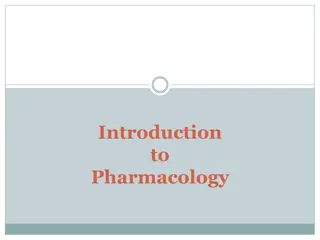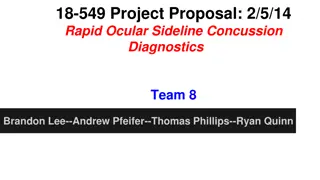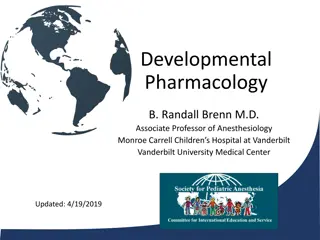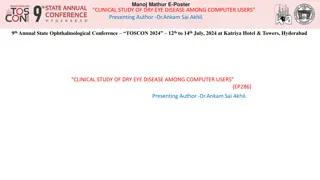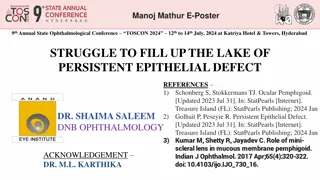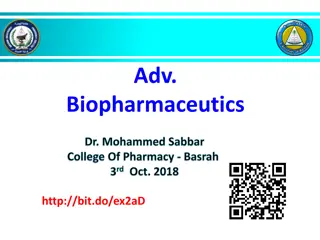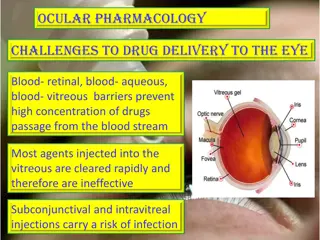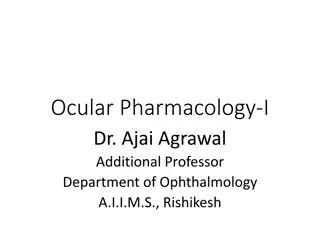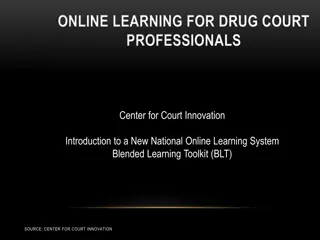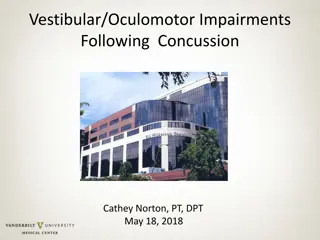Understanding Ocular Pharmacology: General Principles and Drug Delivery
The study of ocular pharmacology involves understanding general pharmacological principles, pharmacodynamics, and pharmacokinetics. Drugs can be delivered to ocular tissue locally via eye drops, ointments, injections, or systemically through oral or intravenous routes. Factors such as drug concentration, solubility, viscosity, and lipid solubility influence the penetration of drugs into ocular tissues. This knowledge is crucial for effective treatment of eye conditions.
Download Presentation

Please find below an Image/Link to download the presentation.
The content on the website is provided AS IS for your information and personal use only. It may not be sold, licensed, or shared on other websites without obtaining consent from the author. Download presentation by click this link. If you encounter any issues during the download, it is possible that the publisher has removed the file from their server.
E N D
Presentation Transcript
Ocular pharmacology and toxicology Abdullah Al-Mousa, MD Assistant Professor, Vitreo-Retinal Surgery Department of Ophthalmology College of Medicine King Saud University
The study of ocular pharmacology begins with a review of some general principles of pharmacology, with particular attention to special features of eye.
Pharmaco-dynamics It is the biological and therapeutic effect of the drug (mechanism of action) Most drugs act by binding to regulatory macromolecules, usually neurotransmitters or hormone receptors or enzymes If the drug is working at the receptor level, it can be agonist or antagonist If the drug is working at the enzyme level, it can be activator or inhibitor
Pharmaco-kinetics To achieve a therapeutic effect, a drug must reach its site of action in sufficient concentration. It is the absorption, distribution, metabolism, and excretion of the drug
The concentration at site of action is a function of the following: Amount administered Extent and rate of absorption at administration site Distribution and binding in tissues Transport between compartments Biotransformation Excretions
A drug can be delivered to ocular tissue as: Locally: Eye drop Ointment Periocular injection Intraocular injection Systemically: Orally IV
Factors Influencing Local Drug Penetration into Ocular Tissue Drug concentration and solubility: the higher the concentration the better the penetration e.g pilocarpine 1-4% but limited by reflex tearing Viscosity: addition of methylcellulose and polyvinyl alcohol increases drug penetration by increasing the contact time with the cornea and altering corneal epithelium Lipid solubility: because of the lipid rich environment of the epithelial cell membranes, the higher lipid solubility the more the penetration.
Factors Influencing Local Drug Penetration into Ocular Tissue Surfactants: the preservatives used in ocular preparations alter cell membrane in the cornea and increase drug permeability e.g. benzylkonium and thiomersal pH: the normal tear pH is 7.4 and if the drug pH is much different, this will cause reflex tearing
Eye drops Eye drops- most common one drop = 50 l volume of conjunctival cul-de-sac = 10 l 20% of administrated drug is retained Rapid turnover of tears occurs: 50% remains after 4 minutes & only 17% after 10 minutes of the drug that reached the tear reservoir.
Measures to increase drop absorption: -wait 5-10 minutes between drops -compress lacrimal sac -keep lids closed for 5 minutes after instillation
Ointments Increase the contact time of ocular medication to ocular surface thus better effect It has the disadvantage of vision blurring The drug has to be high lipid soluble with some water solubility to have the maximum effect as ointment
Peri-ocular injections They reach behind iris-lens diaphragm better than topical application E.g. subconjunctival, subtenon, peribulbar, or retrobulbar This route bypass the conjunctival and corneal epithelium which is good for drugs with low lipid solubility (e.g. penicillin) Also steroid and local anesthetics can be applied this way
Intraocular injections Intracameral or intravitreal: Intracameral acetylcholine (miochol) during cataract surgery Intravitreal antibiotics in cases of endophthalmitis Intravitreal steroids in macular edema Intravitreal Anti-VEGF for DR
Sustained-release devices These are devices that deliver an adequate supply of medication at a steady-state level E.g. Ozerdex sustained release dexamethasone Timoptic XE delivering timolol Ganciclovir sustained-release intraocular device Collagen shields
Systemic drugs Oral or IV Factor influencing systemic drug penetration into ocular tissue: lipid solubility of the drug: more penetration with high lipid solubility Protein binding: more effect with low protein binding Eye inflammation: more penetration with ocular inflammation
Cholinergic agonists Directly acting agonists: E.g. pilocarpine, acetylcholine (miochol), carbachol (miostat) Uses:miosis, glaucoma Mechanisms: Miosis by contraction of the iris sphincter muscle increases aqueous outflow through the trabecular meshwork by longitudinal ciliary muscle contraction Accommodation by circular ciliary muscle contraction Side effects: Local: diminished vision (myopia), headache, cataract, miotic cysts, and rarely retinal detachment systemic side effects: lacrimation, salivation, perspiration, bronchial spasm, urinary urgency, nausea, vomiting, and diarrhea
Cholinergic agonists Indirectly acting (anti-cholinesterases) : More potent with longer duration of action Reversible inhibitors e.g. physostigmine used in glaucoma and lice infestation of lashes can cause CNS side effects
Cholinergic agonists Indirectly acting (anticholinesterases): Irreversible: e.g. phospholine iodide Uses: in accommodative esotropia side effects: iris cyst and anterior subcapsular cataract C/I in angle closure glaucoma, asthma, Parkinsonism causes apnea if used with succinylcholine or procaine
Cholinergic antagonists E.g. tropicamide, cyclopentolate, homatropine, scopolamine, atropine Causemydriasis (by paralyzing the sphincter muscle) with cycloplegia (by paralyzing the ciliary muscle) Uses: fundoscopy, cycloplegic refraction, anterior uveitis Side effects: local: allergic reaction, blurred vision Systemic: nausea, vomiting, pallor, vasomotor collapse, constipation, urinary retention, and confusion specially in children they might cause flushing, fever, tachycardia, or delerium Treatment by DC or physostigmine
Adrenergic agonists Non-selective agonists ( 1, 2, 1, 2) E.g. epinephrine, depevefrin (pro-drug of epinephrine) Uses: glaucoma Side effects: headache, arrhythmia, increased blood pressure, conjunctival adrenochrome, cystoid macular edema in aphakic eyes C/I in closed angle glaucoma
Adrenergic Agonists Alpha-1 agonists E.g. phenylepherine Uses: mydriasis (without cycloplegia), decongestant Adverse effect: Can cause significant increase in blood pressure specially in infant and susceptible adults Rebound congestion precipitation of acute angle-closure glaucoma in patients with narrow angles
Adrenergic agonists Alpha-2 agonists E.g. brimonidine, apraclonidine Uses: glaucoma treatment, prophylaxis against IOP spiking after glaucoma laser procedures Mechanism: decrease aqueous production, and increase uveoscleral outflow Side effects: local: allergic reaction, mydriasis, lid retraction, conjunctival blanching systemic: oral dryness, headache, fatigue, drowsiness, orthostatic hypotension, vasovagal attacks Contraindications:infants, MAO inhibitors users
Beta-adrenergic blockers E.g. non-selective: timolol, levobunolol selective: betaxolol (beta 1 cardioselective ) Uses: glaucoma Mechanism: reduce the formation of aqueous humor by the ciliary body Side effects: bronchospasm (less with betaxolol), cardiac impairment
Carbonic Anhydrase Inhibitors E.g. acetazolamide, methazolamide, dorzolamide, brinzolamide. Uses: glaucoma, cystoid macular edema, pseudo-tumour cerebri Mechanism: aqueous suppression Side effects: myopia, parasthesia, anorexia, GI upset, headache, altered taste and smell, Na and K depletion, metabolic acidosis, renal stone, bone marrow suppression aplastic anemia Contraindication: sulpha allergy, digitalis users, pregnancy
Osmotic agents Dehydrate vitreous body which reduce IOP significantly E.G. Glycerol 50% syrup (cause nausea, hyperglycemia) Mannitol 20% IV (cause fluid overload and not used in heart failure)
Prostaglandin Analogues E.g. latanoprost, bimatoprost, travoprost Uses: glaucoma Mechanism: increase uveoscleral aqueous outflow Side effects: darkening of the iris (heterochromia iridis), lengthening and thickening of eyelashes, intraocular inflammation, macular edema
Anti- inflammatory Corticosteroid NSAID
Corticosteroids Topical E.g. fluorometholone, prednisolone, dexamethasone, hydrocortisone Mechanism: inhibition of arachidonic acid release from phospholipids by inhibiting phospholipase A2 Uses: postoperatively, anterior uveitis, severe allergic conjunctivitis, vernal keratoconjunctivitis, prevention and suppression of corneal graft rejection, episcleritis, scleritis Side effects: susceptibility to infections, glaucoma, cataract, scleral melting, skin atrophy
Corticosteroids Systemic: E.g. prednisolone, methylprednisolone Uses: posterior uveitis, optic neuritis, temporal arteritis with anterior ischemic optic neuropathy Side effects: Local: posterior subcapsular cataract, glaucoma, central serous retinopathy Systemic: suppression of pituitary-adrenal axis, hyperglycemia, osteoporosis, peptic ulcer, psychosis
NSAIDs E.g. ketorolac, diclofenac, nepafenac Mechanism: inactivation of cyclo-oxygenase Uses: post-operatively, episcleritis/scleritis, mild uveitis, cystoid macular edema, preoperatively to prevent miosis during surgery Side effects: stinging and burning. Rarely: corneal erosion or melting
Anti-allergy Avoidance of allergens, cold compress, lubrications Antihistamines (e.g.pheniramine, levocabastine) Decongestants (e.g. naphazoline, phenylepherine, tetrahydrozaline) Mast cell stabilizers (e.g. cromolyn, nedocromil, olopatadine) NSAID (e.g. ketorolac) Steroids (e.g. fluorometholone, prednisolone) Drug combinations
Antibiotics Penicillins Cephalosporins Sulfonamides Tetracyclines Chloramphenicol Aminoglycosides Fluoroquinolones Vancomycin Macrolides
Antibiotics Used topically in prophylaxis (pre and postoperatively) and treatment of ocular bacterial infections. Used orally for the treatment of preseptal cellulitis e.g. amoxycillin with clavulonate, cefaclor Used intravenously for the treatment of orbital cellulitis e.g. gentamicin, cephalosporin, vancomycin, flagyl Can be injected intravitrally for the treatment of endophthalmitis
Antibiotics Trachoma can be treated by topical and systemic tetracycline or erythromycin, or systemic azithromycin. Bacterial keratitis (bacterial corneal ulcers) can be treated by topical fortified penicillins, cephalosporins, aminoglycosides, vancomycin or fluoroquinolones. Bacterial conjunctivitis is usually self limited but topical erythromycin, aminoglycosides, fluoroquinolones, or chloramphenicol can be used
Antifungals Uses: fungal keratitis, fungal endophthalmitis Polyenes damage cell membrane of susceptible fungi e.g. amphotericin B, natamycin side effect: nephrotoxicity Imidazoles increase fungal cell membrane permeability e.g. miconazole, ketoconazole Flucytocine act by inhibiting DNA synthesis
Antivirals Acyclovir Interact with viral thymidine kinase (selective) Used in herpetic keratitis Trifluridine More corneal penetration Can treat herpetic iritis Ganciclovir Used intravenously for CMV retinitis
Ocular diagnostic drugs Fluorescein dye Available as drops or strips Uses: stain corneal abrasions, applanation tonometry, detecting wound leak, NLD obstruction, fluorescein angiography Caution: stains soft contact lens Fluorescein drops can be contaminated by Pseudomonas sp.
Ocular diagnostic drugs Rose bengal stain Stains devitalized epithelium Uses: severe dry eye, herpetic keratitis
Local Anesthetics Topical E.g. propacaine, tetracaine Uses: applanation tonometry, goniscopy, removal of corneal foreign bodies, removal of sutures, examination of patients who cannot open eyes because of pain Adverse effects: toxic to corneal epithelium, allergic reaction rarely
Local Anesthetics Orbital infiltration peribulbar or retrobulbar cause anesthesia and akinesia for intraocular surgery e.g. lidocaine, bupivacaine
Other Ocular Preparations Lubricants drops or ointments Polyvinyl alcohol, methylcellulose or hyaluronic acid Preserved or preservative free
Complications of Topical Administration Mechanical injury from the bottle e.g. corneal abrasion Pigmentation: epinephrine-adrenochrome Ocular damage: e.g. topical anesthetics, benzalkonium preservative Hypersensitivity: e.g. atropine, neomycin, gentamicin Systemic effect: topical phenylephrine can increase BP
Amiodarone A cardiac arrhythmia drug Causes optic neuropathy (mild decreased vision, visual field defects, bilateral optic disc swelling) Also causes corneal vortex keratopathy (corneal verticillata) which is whorl-shaped pigmented deposits in the corneal epithelium
Digitalis A cardiac failure drug Causes chromatopsia (objects appear yellow) with overdose
Chloroquines E.g. chloroquine, hydroxychloroquine Used in malaria, rheumatoid arthritis & SLE Cause vortex keratopathy (corneal verticillata) which is usually asymptomatic but can present with glare and photophobia Also cause retinopathy (bull s eye maculopathy)
Chlorpromazine A psychiatric drug Causes corneal punctate epithelial opacities, lens surface opacities. Reversible with drug discontinuation Pigmentary retinopathy in high doses




